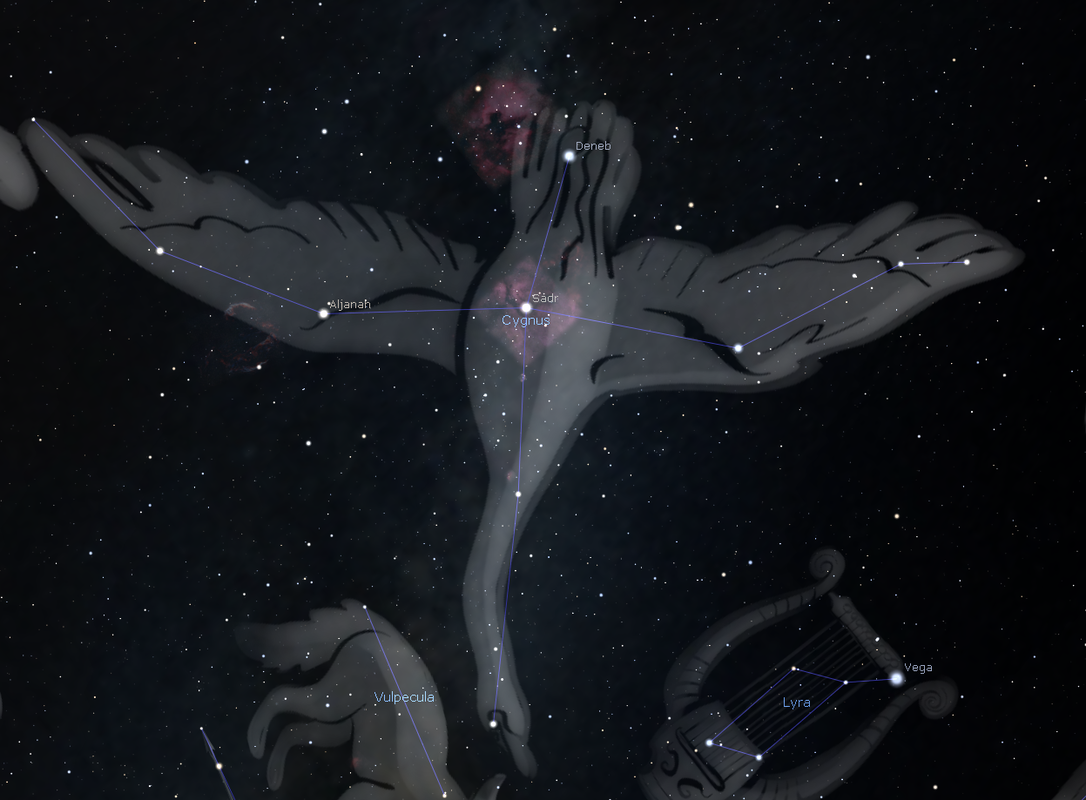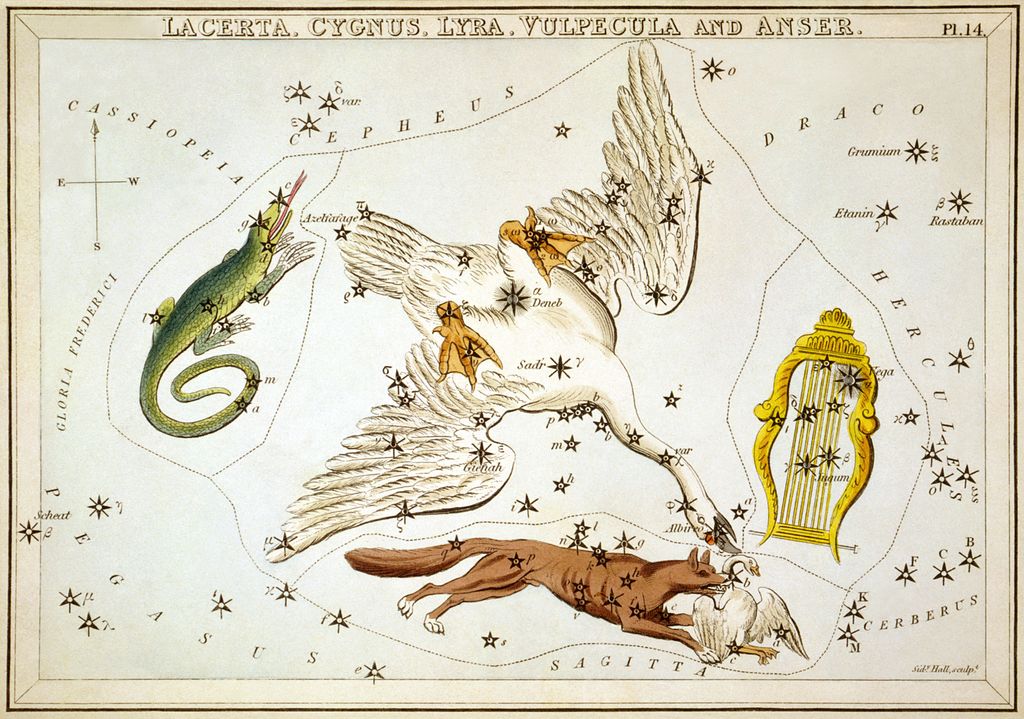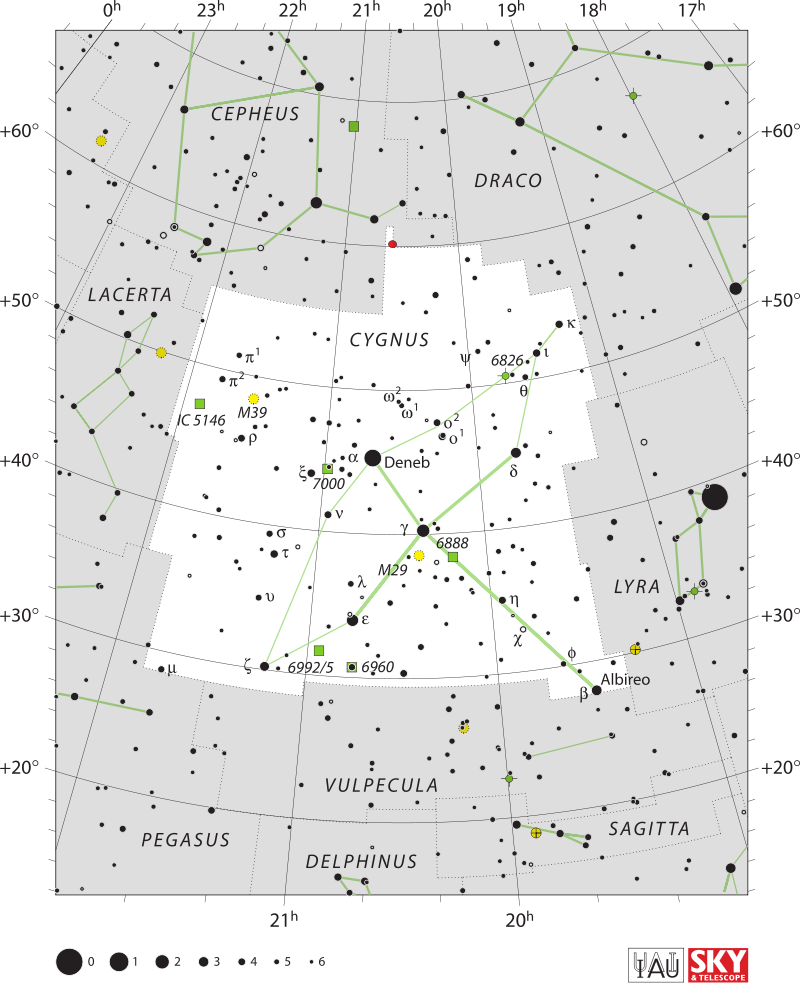|
Cygnus is a Milky Way constellation in the northern hemisphere that gets its name from the Latinized Greek word for swan. Cygnus is one of the most well-known constellations in the northern summer and fall, and it contains the Northern Cross, a renowned asterism (in contrast to the Southern Cross). Cygnus was one of the 48 constellations listed by Claudius Ptolemy in the second century, and it is now one of the 88 contemporary constellations.
Deneb (ذنب, translate. anab, tail) is Cygnus' "tail star" and one of the Summer Triangle's corners. Deneb is one of the brightest stars in the night sky and the most distant first-magnitude star. It also features some prominent X-ray sources, as well as the Cygnus OB2 big star association. The Northern Cross is another name for Cygnus. NML Cygni, one of the stars in this association, is one of the biggest stars known. Cygnus X-1, a distant X-ray binary featuring a supergiant and undetected huge partner that was the first object commonly thought to be a black hole, is also found in the constellation. As a result of the Kepler Mission monitoring one area of the sky, several star systems in Cygnus have known planets. The Hercules–Corona Borealis Great Wall, which covers most of the northern sky and is the biggest known structure in the observable cosmos, may be seen in the deep sky from most of the east. |
|
History and Mythology
Eastern and World Astronomy The Brahmamuhurtha, which means "the moment of the Universe" in Hinduism, is the period of time (or Muhurta) between 4:24 AM and 5:12 AM; the star system in correlation is the Cygnus constellation. This is considered an excellent hour to meditate, perform any job, or begin the day. Cygnus was often identified as a unique constellation in Polynesia. Tuula-lupe was the name given to it in Tonga, and Fanui-tai was the name given to it among the Tuamotus. It was known as Mara-tea in New Zealand, Pirae-tea in the Society Islands, or Taurua-i-te-haapa-raa-manu in the Tuamotus, and Fanui-raro in the Tuamotus. Whetu-kaupo was most likely the name given to Beta Cygni when it was discovered in New Zealand. In the Tuamotus, Gamma Cygni was known as Fanui-runga. (Makemson 1941) In the Islamic world of astronomy, Deneb was also a given name. Deneb is derived from the Arabic word dhaneb, which means "tail," as well as the phrase Dhanab ad-Dajjah, which means "the hen's tail." |
Western and Greek Astronomy
Cygnus has been associated with several legendary swans in Greek mythology. Zeus disguised himself as a swan to seduce Leda, the Spartan king Tyndareus's wife, who gave birth to the Gemini, Helen of Troy, and Clytemnestra; (Ridpath & Tirion 2001) Orpheus was transformed into a swan after his murder and was said to have been placed in the sky next to his lyre (Lyra); and King Cygnus was transformed into a swan after his murder.
This constellation was also linked to the tragic narrative of Phaethon, the sun god's son, who requested to ride in his father's sun chariot for a day. However, Phaethon was unable to keep control of the reins, prompting Zeus to strike the chariot (and Phaethon) with a thunderbolt, causing it to crash to the ground and into the river Eridanus. According to legend, Phaethon's close friend or lover, Cygnus, wept deeply and spent days plunging into the river to retrieve Phaethon's bones so that he may be properly buried. Cygnus' dedication moved the gods so much that they transformed him into a swan and set him among the stars. (Chen 2007)
Three characters named Cygnus appear in Ovid's Metamorphoses, all of whom are transformed into swans. Along with Cygnus, he recalls a Tempe lad who attempts suicide when Phyllius refuses to give him the tamed bull he desires but is converted into a swan and flees. He also describes Neptune's son, an invincible warrior in the Trojan War who is eventually beaten by Achilles but is saved by Neptune by converting him into a swan.
Cygnus, along with other avian constellations near the summer solstice, Vultur cadens and Aquila, may have played a role in the tale of the Stymphalian Birds, one of Hercules' Twelve Labours. (Allen 1963)
Cygnus has been associated with several legendary swans in Greek mythology. Zeus disguised himself as a swan to seduce Leda, the Spartan king Tyndareus's wife, who gave birth to the Gemini, Helen of Troy, and Clytemnestra; (Ridpath & Tirion 2001) Orpheus was transformed into a swan after his murder and was said to have been placed in the sky next to his lyre (Lyra); and King Cygnus was transformed into a swan after his murder.
This constellation was also linked to the tragic narrative of Phaethon, the sun god's son, who requested to ride in his father's sun chariot for a day. However, Phaethon was unable to keep control of the reins, prompting Zeus to strike the chariot (and Phaethon) with a thunderbolt, causing it to crash to the ground and into the river Eridanus. According to legend, Phaethon's close friend or lover, Cygnus, wept deeply and spent days plunging into the river to retrieve Phaethon's bones so that he may be properly buried. Cygnus' dedication moved the gods so much that they transformed him into a swan and set him among the stars. (Chen 2007)
Three characters named Cygnus appear in Ovid's Metamorphoses, all of whom are transformed into swans. Along with Cygnus, he recalls a Tempe lad who attempts suicide when Phyllius refuses to give him the tamed bull he desires but is converted into a swan and flees. He also describes Neptune's son, an invincible warrior in the Trojan War who is eventually beaten by Achilles but is saved by Neptune by converting him into a swan.
Cygnus, along with other avian constellations near the summer solstice, Vultur cadens and Aquila, may have played a role in the tale of the Stymphalian Birds, one of Hercules' Twelve Labours. (Allen 1963)
Characteristics
Cepheus to the north and east, Draco to the north and west, Lyra to the west, Vulpecula to the south, Pegasus to the southeast, and Lacerta to the east are the constellations that surround Cygnus. The IAU chose the three-letter abbreviation "Cyg" for the constellation in 1922. (Russell 1922) Belgian astronomer Eugène Delporte defined the official constellation limits in 1930 as a polygon with 28 parts. The right ascension coordinates of these borders are between 19h 07.3m and 22h 02.3m in the equatorial coordinate system, while the declination coordinates are between 27.73° and 61.36°. Cygnus is the 16th largest constellation in the night sky, covering 804 square degrees and 1.9 percent of the sky. (Thompson & Thompson 2007)
Cygnus peaks at midnight on June 29th and is most visible in the evenings in the Northern Hemisphere from early summer to mid-autumn. (Thompson & Thompson 2007)
Cygnus' wings are usually portrayed as Delta and Epsilon Cygni. At its tail is Deneb, the brightest star in the constellation, while Albireo is at the tip of its beak. (Ridpath & Tirion 2001)
Cygnus contains several asterisms. Alpha, Beta, and Gamma Cygni form the pole of a cross in the Uranometria, a 17th-century German celestial cartographer's star atlas, while Delta and Epsilon form the cross beam. The nova P Cygni was then thought to be Christ's body. (Wagman 2003)
Cepheus to the north and east, Draco to the north and west, Lyra to the west, Vulpecula to the south, Pegasus to the southeast, and Lacerta to the east are the constellations that surround Cygnus. The IAU chose the three-letter abbreviation "Cyg" for the constellation in 1922. (Russell 1922) Belgian astronomer Eugène Delporte defined the official constellation limits in 1930 as a polygon with 28 parts. The right ascension coordinates of these borders are between 19h 07.3m and 22h 02.3m in the equatorial coordinate system, while the declination coordinates are between 27.73° and 61.36°. Cygnus is the 16th largest constellation in the night sky, covering 804 square degrees and 1.9 percent of the sky. (Thompson & Thompson 2007)
Cygnus peaks at midnight on June 29th and is most visible in the evenings in the Northern Hemisphere from early summer to mid-autumn. (Thompson & Thompson 2007)
Cygnus' wings are usually portrayed as Delta and Epsilon Cygni. At its tail is Deneb, the brightest star in the constellation, while Albireo is at the tip of its beak. (Ridpath & Tirion 2001)
Cygnus contains several asterisms. Alpha, Beta, and Gamma Cygni form the pole of a cross in the Uranometria, a 17th-century German celestial cartographer's star atlas, while Delta and Epsilon form the cross beam. The nova P Cygni was then thought to be Christ's body. (Wagman 2003)
Deep-sky Objects
Because of its location on the Milky Way, Cygnus has an abundance of deep-sky objects, including several open clusters, nebulae of various sorts, and supernova remnants. From a dense background of stars, some open clusters can be difficult to spot. (Thompson & Thompson 2007)
M39 – Open Cluster
NGC 6910 – Open Cluster (Rocking Horse Cluster)
NGC 6826 – Blinking Planetary Nebula
NGC 7000 – Emission Nebula – one of the most well known in the region
NGC 6960, 6979, 6992 and 6995 – Veil Nebula – also known as the Cygnus Loop – Supernova Remnant
DR 6 – Nebula with newly born stars 10-20 times larger than our sun
Great Rift – Dark Nebula
IC 1318 – Diffuse Emission Nebula
NGC 6888 – Crescent Nebula
PN G75.5+1.7 – Soap Bubble Nebula – Planetary Nebula
Cygnus X – Massive star forming region
3C 405 – Cygnus A – Radio Galaxy – Elliptical Galaxy in appearance in the visible wavelength
Main stars - 9
Bayer stars - 84
Stars with planets - 97
Stars brighter than magnitude 3.00 - 4
Stars within 32 ly - 1
Bordering
constellations
Meteor showers
Because of its location on the Milky Way, Cygnus has an abundance of deep-sky objects, including several open clusters, nebulae of various sorts, and supernova remnants. From a dense background of stars, some open clusters can be difficult to spot. (Thompson & Thompson 2007)
M39 – Open Cluster
NGC 6910 – Open Cluster (Rocking Horse Cluster)
NGC 6826 – Blinking Planetary Nebula
NGC 7000 – Emission Nebula – one of the most well known in the region
NGC 6960, 6979, 6992 and 6995 – Veil Nebula – also known as the Cygnus Loop – Supernova Remnant
DR 6 – Nebula with newly born stars 10-20 times larger than our sun
Great Rift – Dark Nebula
IC 1318 – Diffuse Emission Nebula
NGC 6888 – Crescent Nebula
PN G75.5+1.7 – Soap Bubble Nebula – Planetary Nebula
Cygnus X – Massive star forming region
3C 405 – Cygnus A – Radio Galaxy – Elliptical Galaxy in appearance in the visible wavelength
Main stars - 9
Bayer stars - 84
Stars with planets - 97
Stars brighter than magnitude 3.00 - 4
Stars within 32 ly - 1
Bordering
constellations
- Cepheus
- Draco
- Lyra
- Vulpecula
- Pegasus
- Lacerta
Meteor showers
- Kappa Cygnids – June through to September – Peak mid-August every 7 years.


